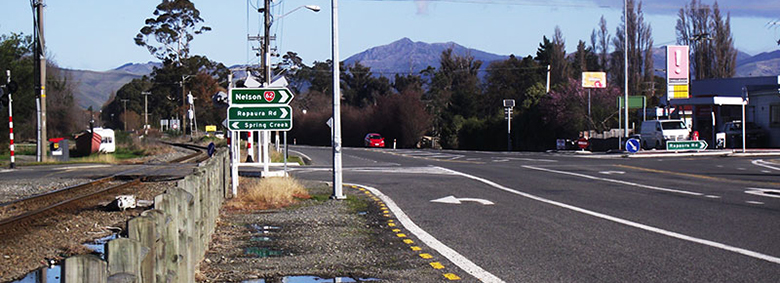Safety is the common thread for state highway projects throughout the Transport Agency’s Central region.

The Transport Agency has many highway projects on the go and gearing up across the region. These projects target all manner of outcomes from reducing congestion to increasing freight efficiency to improving the resilience of our transport network. Whatever the goal, there is a common element built into all of our projects, and that is safety.
At the top of the South Island, there is a history of safety issues at the Spring Creek intersection north of Blenheim. Nearly 90 percent of crashes on this stretch of road in the last ten years have happened while a driver was turning at the intersection. The Transport Agency has consulted extensively with the local community and is currently working on final designs for a roundabout that will simplify how people turn on to, or off, the highway. A roundabout reduces the conflict points at four legged intersections like this one from 24 to just four. Construction could start in 2015, contingent on the approval of final designs and construction funding.
Working in consultation with the local community, the Transport Agency has also designed some much needed safety enhancements through Manakau and Ohau, north of Wellington. The work includes lowering the speed limit through the townships, but it also focuses on making the road more self-explaining. Self-explaining roads are one of the principles underpinning the Government’s Safer Journeys 2020 Strategy, and includes driver awareness measures and information that drivers can use to make decisions and modify their behaviour. In this case, measures will recognise that the highway is passing through populated areas and make the accompanying lower speed limit more intuitive for drivers.
A significant programme of safety improvements is also getting under way on State Highway 58, which runs between State Highway 2 in the Hutt Valley and State Highway 1 north of Porirua. This will include earthworks to straighten difficult curves and widen the road in some places, and changes to the speed limit to better reflect the challenges of the road. The programme also includes the installation of a wire rope barrier along one part of the road. Wire rope barriers are a valuable safety tool, having played a significant role in eliminating fatal crashes along the Centennial Highway segment of State Highway 1 since they were installed.
In New Plymouth, the Vickers to City project on State Highway 3 will improve capacity through what is currently a major bottleneck for the city. As a key local freight route, this is an important economic upgrade. The project will result in higher vehicle capacity, greater separation of opposing lanes, improved intersection layouts, and new and upgraded walking and cycling facilities. The safety enhancements will play their part in the economic story too, as the Transport Agency anticipates savings of up to $100,000 every year as the number of crashes reduces.
On the other side of the country, passing opportunities are making it safer for cars and trucks to share the road. Earlier this year, the Transport Agency added nine passing lanes and slow vehicle bays on State Highway 2 between Napier and Gisborne, at a total cost of $4 million. The Transport Agency is now starting work to add two slow vehicle bays on State Highway 35 north of Gisborne. This is the first of the Central region’s projects funded as part of the Government’s Accelerated Regional Roading Package. These improvements will result in both safety and economic benefits as the slow vehicle bays will reduce congestion caused by increasing volumes of heavy freight traffic. In turn, this will reduce the likelihood that other drivers might take unnecessary risks.
The Transport Agency’s ongoing commitment to safety and safer speeds is further detailed on the Safer Journeys website(external link).